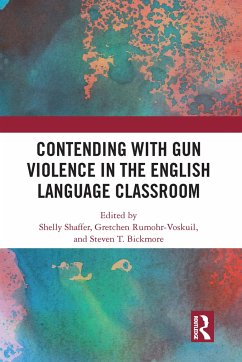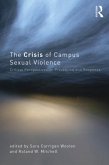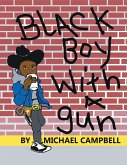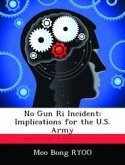Contending with Gun Violence in the English Language Classroom
Herausgeber: Shaffer, Shelly; Bickmore, Steven; Rumohr-Voskuil, Gretchen
Contending with Gun Violence in the English Language Classroom
Herausgeber: Shaffer, Shelly; Bickmore, Steven; Rumohr-Voskuil, Gretchen
- Broschiertes Buch
- Merkliste
- Auf die Merkliste
- Bewerten Bewerten
- Teilen
- Produkt teilen
- Produkterinnerung
- Produkterinnerung
Utilizing experiences and expertise from English educators, young adult literature authors, classroom teachers, and mental health professionals, this book considers how secondary English Language Arts can address school gun violence. Curated by field experts, contributions to this volume pay special attention to how a school's culture and climate affect how teachers and students communicate around difficult topics that are embedded in the curriculum, but not directly addressed. As the first book that helps teachers and teacher educators to grapple with the topic of school violence specifically…mehr
Andere Kunden interessierten sich auch für
![The Crisis of Campus Sexual Violence The Crisis of Campus Sexual Violence]() The Crisis of Campus Sexual Violence60,99 €
The Crisis of Campus Sexual Violence60,99 €![Curriculum and the Problem of Violence Curriculum and the Problem of Violence]() James P. BurnsCurriculum and the Problem of Violence56,99 €
James P. BurnsCurriculum and the Problem of Violence56,99 €![Black Boy with a Gun Black Boy with a Gun]() Michael CampbellBlack Boy with a Gun25,99 €
Michael CampbellBlack Boy with a Gun25,99 €![Using a Gatling-Gun Configured Micro Pulsed Plasma Thruster as a Means to Control Micro Satellites with Extreme Precision Using a Gatling-Gun Configured Micro Pulsed Plasma Thruster as a Means to Control Micro Satellites with Extreme Precision]() Lee I. WatsonUsing a Gatling-Gun Configured Micro Pulsed Plasma Thruster as a Means to Control Micro Satellites with Extreme Precision52,99 €
Lee I. WatsonUsing a Gatling-Gun Configured Micro Pulsed Plasma Thruster as a Means to Control Micro Satellites with Extreme Precision52,99 €![No Gun Ri Incident: Implications for the U.S. Army No Gun Ri Incident: Implications for the U.S. Army]() Moo Bong RyooNo Gun Ri Incident: Implications for the U.S. Army52,99 €
Moo Bong RyooNo Gun Ri Incident: Implications for the U.S. Army52,99 €![Assemblages of Violence in Education Assemblages of Violence in Education]() Boni WozolekAssemblages of Violence in Education55,99 €
Boni WozolekAssemblages of Violence in Education55,99 €![Educating for Peace through Countering Violence Educating for Peace through Countering Violence]() Educating for Peace through Countering Violence57,99 €
Educating for Peace through Countering Violence57,99 €-
-
-
Utilizing experiences and expertise from English educators, young adult literature authors, classroom teachers, and mental health professionals, this book considers how secondary English Language Arts can address school gun violence. Curated by field experts, contributions to this volume pay special attention to how a school's culture and climate affect how teachers and students communicate around difficult topics that are embedded in the curriculum, but not directly addressed. As the first book that helps teachers and teacher educators to grapple with the topic of school violence specifically in the English education classroom, this book promotes young adult literature and writing activities that address timely and unfortunately recurring events.
Produktdetails
- Produktdetails
- Verlag: Routledge
- Seitenzahl: 156
- Erscheinungstermin: 30. Juni 2020
- Englisch
- Abmessung: 229mm x 152mm x 9mm
- Gewicht: 237g
- ISBN-13: 9780367582777
- ISBN-10: 0367582775
- Artikelnr.: 66557531
- Herstellerkennzeichnung
- Libri GmbH
- Europaallee 1
- 36244 Bad Hersfeld
- gpsr@libri.de
- Verlag: Routledge
- Seitenzahl: 156
- Erscheinungstermin: 30. Juni 2020
- Englisch
- Abmessung: 229mm x 152mm x 9mm
- Gewicht: 237g
- ISBN-13: 9780367582777
- ISBN-10: 0367582775
- Artikelnr.: 66557531
- Herstellerkennzeichnung
- Libri GmbH
- Europaallee 1
- 36244 Bad Hersfeld
- gpsr@libri.de
Shelly L. Shaffer is an assistant professor of Literacy at Eastern Washington University, USA. Gretchen Rumohr-Voskuil is an associate professor and chair of English at Aquinas College, USA. Steven T. Bickmore is an associate professor of English Education at the University of Nevada, Las Vegas, USA.
i. Preface by Ashley S. Boyd
ii. Introduction by Steve Bickmore, Gretchen Rumohr-Voskuil, and Shelly
Shaffer
iii. Section 1: Gun Violence in Schools: What Does History Tell Us?
1. Chapter 1. Exploring School Violence as a YA Author by Chris Crutcher
2. Chapter 2. History of Violence: Guns, U.S. Education, and American
Exceptionalism by Paul Thomas
3. Chapter 3. Unreal: How the Rest of the World Views U.S. Gun Policy by
David Belbin
4. Chapter 4. #NeverAgain: Considering the Marjory Stoneman Douglas High
School Student Activists' Media Representations through a Youth Lens
by Chris Goering
iv. Section 2: Reading About School Violence: Books that Explore School
Shootings and Their Aftermath
1. Chapter 5. What Do We Know? and What Can We Do?: Using Mercy Rule to
Help Students Understand the Causes and Warning Signs of School
Violence by Jim Blasingame
2. Chapter 6. Looking for Hope--and Helpers--in Forgive Me, Leonard
Peacock by Gretchen Rumohr-Voskuil
3. Chapter 7. Adolescent Counter-Storytelling: Finding Youth Voice and
Truth in That's Not What Happened by Shelly Shaffer.
4. Chapter 8. Exploring the Blame Game Through the Lens of the Scout:
Reading and Writing about Give a Boy a Gun by Melissa
Williamson-Pulkkinen
v. Section 3: Recovering from Trauma, Finding Allies, and Taking Action
Towards Social Justice
1. Chapter 9. Welcoming Ghosts into Our Classroom: Long Way Down by
Jason Reynolds by Sarah Donovan
2. Chapter 10. This is not a Drill: Exploring the After-Effects of
Traumatic Events with Are you still there? by Sarah Lynn Scheerger by
Maria Hernandez Goff
3. Chapter 11. What He Knows and What He Will Say: Voicing for Justice
in All American Boys by Jason Reynolds and Brendan Kiely by Alice
Hays
4. Chapter 12. Making Good Trouble: John Lewis, Andrew Aydin, and Nate
Powell's March Trilogy and the Lessons of the Civil Rights Movement
by Meghan Sweeney
vi. Section 4: Writing Beyond Fear by Addressing the Issues
1. Chapter 13. On Rhetorical Analysis, Teaching, and the American
Culture of Guns by Jonathan Bush
2. Chapter 14. Writing through Pain: How Teachers can Support Writing as
Therapy for Students Processing Trauma by Jason Griffith
3. Chapter 15. Writing in the Margins: Students' Voices in the Aftermath
of Trauma by Jim Fredricksen and Joe Dillon
vii. Section 5: Arming Teachers with Words, Stories, and Power
1. Chapter 16. When the Gun isn't Metaphorical: Educating Teachers in
the Age of School Shootings by Melanie Shoffner
ii. Introduction by Steve Bickmore, Gretchen Rumohr-Voskuil, and Shelly
Shaffer
iii. Section 1: Gun Violence in Schools: What Does History Tell Us?
1. Chapter 1. Exploring School Violence as a YA Author by Chris Crutcher
2. Chapter 2. History of Violence: Guns, U.S. Education, and American
Exceptionalism by Paul Thomas
3. Chapter 3. Unreal: How the Rest of the World Views U.S. Gun Policy by
David Belbin
4. Chapter 4. #NeverAgain: Considering the Marjory Stoneman Douglas High
School Student Activists' Media Representations through a Youth Lens
by Chris Goering
iv. Section 2: Reading About School Violence: Books that Explore School
Shootings and Their Aftermath
1. Chapter 5. What Do We Know? and What Can We Do?: Using Mercy Rule to
Help Students Understand the Causes and Warning Signs of School
Violence by Jim Blasingame
2. Chapter 6. Looking for Hope--and Helpers--in Forgive Me, Leonard
Peacock by Gretchen Rumohr-Voskuil
3. Chapter 7. Adolescent Counter-Storytelling: Finding Youth Voice and
Truth in That's Not What Happened by Shelly Shaffer.
4. Chapter 8. Exploring the Blame Game Through the Lens of the Scout:
Reading and Writing about Give a Boy a Gun by Melissa
Williamson-Pulkkinen
v. Section 3: Recovering from Trauma, Finding Allies, and Taking Action
Towards Social Justice
1. Chapter 9. Welcoming Ghosts into Our Classroom: Long Way Down by
Jason Reynolds by Sarah Donovan
2. Chapter 10. This is not a Drill: Exploring the After-Effects of
Traumatic Events with Are you still there? by Sarah Lynn Scheerger by
Maria Hernandez Goff
3. Chapter 11. What He Knows and What He Will Say: Voicing for Justice
in All American Boys by Jason Reynolds and Brendan Kiely by Alice
Hays
4. Chapter 12. Making Good Trouble: John Lewis, Andrew Aydin, and Nate
Powell's March Trilogy and the Lessons of the Civil Rights Movement
by Meghan Sweeney
vi. Section 4: Writing Beyond Fear by Addressing the Issues
1. Chapter 13. On Rhetorical Analysis, Teaching, and the American
Culture of Guns by Jonathan Bush
2. Chapter 14. Writing through Pain: How Teachers can Support Writing as
Therapy for Students Processing Trauma by Jason Griffith
3. Chapter 15. Writing in the Margins: Students' Voices in the Aftermath
of Trauma by Jim Fredricksen and Joe Dillon
vii. Section 5: Arming Teachers with Words, Stories, and Power
1. Chapter 16. When the Gun isn't Metaphorical: Educating Teachers in
the Age of School Shootings by Melanie Shoffner
i. Preface by Ashley S. Boyd
ii. Introduction by Steve Bickmore, Gretchen Rumohr-Voskuil, and Shelly
Shaffer
iii. Section 1: Gun Violence in Schools: What Does History Tell Us?
1. Chapter 1. Exploring School Violence as a YA Author by Chris Crutcher
2. Chapter 2. History of Violence: Guns, U.S. Education, and American
Exceptionalism by Paul Thomas
3. Chapter 3. Unreal: How the Rest of the World Views U.S. Gun Policy by
David Belbin
4. Chapter 4. #NeverAgain: Considering the Marjory Stoneman Douglas High
School Student Activists' Media Representations through a Youth Lens
by Chris Goering
iv. Section 2: Reading About School Violence: Books that Explore School
Shootings and Their Aftermath
1. Chapter 5. What Do We Know? and What Can We Do?: Using Mercy Rule to
Help Students Understand the Causes and Warning Signs of School
Violence by Jim Blasingame
2. Chapter 6. Looking for Hope--and Helpers--in Forgive Me, Leonard
Peacock by Gretchen Rumohr-Voskuil
3. Chapter 7. Adolescent Counter-Storytelling: Finding Youth Voice and
Truth in That's Not What Happened by Shelly Shaffer.
4. Chapter 8. Exploring the Blame Game Through the Lens of the Scout:
Reading and Writing about Give a Boy a Gun by Melissa
Williamson-Pulkkinen
v. Section 3: Recovering from Trauma, Finding Allies, and Taking Action
Towards Social Justice
1. Chapter 9. Welcoming Ghosts into Our Classroom: Long Way Down by
Jason Reynolds by Sarah Donovan
2. Chapter 10. This is not a Drill: Exploring the After-Effects of
Traumatic Events with Are you still there? by Sarah Lynn Scheerger by
Maria Hernandez Goff
3. Chapter 11. What He Knows and What He Will Say: Voicing for Justice
in All American Boys by Jason Reynolds and Brendan Kiely by Alice
Hays
4. Chapter 12. Making Good Trouble: John Lewis, Andrew Aydin, and Nate
Powell's March Trilogy and the Lessons of the Civil Rights Movement
by Meghan Sweeney
vi. Section 4: Writing Beyond Fear by Addressing the Issues
1. Chapter 13. On Rhetorical Analysis, Teaching, and the American
Culture of Guns by Jonathan Bush
2. Chapter 14. Writing through Pain: How Teachers can Support Writing as
Therapy for Students Processing Trauma by Jason Griffith
3. Chapter 15. Writing in the Margins: Students' Voices in the Aftermath
of Trauma by Jim Fredricksen and Joe Dillon
vii. Section 5: Arming Teachers with Words, Stories, and Power
1. Chapter 16. When the Gun isn't Metaphorical: Educating Teachers in
the Age of School Shootings by Melanie Shoffner
ii. Introduction by Steve Bickmore, Gretchen Rumohr-Voskuil, and Shelly
Shaffer
iii. Section 1: Gun Violence in Schools: What Does History Tell Us?
1. Chapter 1. Exploring School Violence as a YA Author by Chris Crutcher
2. Chapter 2. History of Violence: Guns, U.S. Education, and American
Exceptionalism by Paul Thomas
3. Chapter 3. Unreal: How the Rest of the World Views U.S. Gun Policy by
David Belbin
4. Chapter 4. #NeverAgain: Considering the Marjory Stoneman Douglas High
School Student Activists' Media Representations through a Youth Lens
by Chris Goering
iv. Section 2: Reading About School Violence: Books that Explore School
Shootings and Their Aftermath
1. Chapter 5. What Do We Know? and What Can We Do?: Using Mercy Rule to
Help Students Understand the Causes and Warning Signs of School
Violence by Jim Blasingame
2. Chapter 6. Looking for Hope--and Helpers--in Forgive Me, Leonard
Peacock by Gretchen Rumohr-Voskuil
3. Chapter 7. Adolescent Counter-Storytelling: Finding Youth Voice and
Truth in That's Not What Happened by Shelly Shaffer.
4. Chapter 8. Exploring the Blame Game Through the Lens of the Scout:
Reading and Writing about Give a Boy a Gun by Melissa
Williamson-Pulkkinen
v. Section 3: Recovering from Trauma, Finding Allies, and Taking Action
Towards Social Justice
1. Chapter 9. Welcoming Ghosts into Our Classroom: Long Way Down by
Jason Reynolds by Sarah Donovan
2. Chapter 10. This is not a Drill: Exploring the After-Effects of
Traumatic Events with Are you still there? by Sarah Lynn Scheerger by
Maria Hernandez Goff
3. Chapter 11. What He Knows and What He Will Say: Voicing for Justice
in All American Boys by Jason Reynolds and Brendan Kiely by Alice
Hays
4. Chapter 12. Making Good Trouble: John Lewis, Andrew Aydin, and Nate
Powell's March Trilogy and the Lessons of the Civil Rights Movement
by Meghan Sweeney
vi. Section 4: Writing Beyond Fear by Addressing the Issues
1. Chapter 13. On Rhetorical Analysis, Teaching, and the American
Culture of Guns by Jonathan Bush
2. Chapter 14. Writing through Pain: How Teachers can Support Writing as
Therapy for Students Processing Trauma by Jason Griffith
3. Chapter 15. Writing in the Margins: Students' Voices in the Aftermath
of Trauma by Jim Fredricksen and Joe Dillon
vii. Section 5: Arming Teachers with Words, Stories, and Power
1. Chapter 16. When the Gun isn't Metaphorical: Educating Teachers in
the Age of School Shootings by Melanie Shoffner









